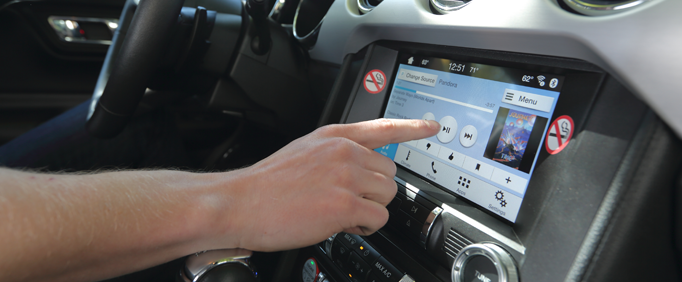
WASHINGTON, D.C. (Oct. 5, 2017) – New vehicle infotainment systems take drivers’ eyes and attention off the road and hands off the wheel for potentially dangerous periods of time, according to new research from the AAA Foundation for Traffic Safety. Drivers using in-vehicle technologies like voice-based and touch screen features were visually and mentally distracted for more than 40 seconds when completing tasks like programming navigation or sending a text message. Removing eyes from the road for just two seconds doubles the risk for a crash, according to previous research. With one in three U.S. adults using infotainment systems while driving, AAA cautions that using these technologies while behind the wheel can have dangerous consequences.
AAA has conducted this new research to help automakers and system designers improve the functionality of new infotainment systems and the demand they place on drivers.
“Some in-vehicle technology can create unsafe situations for drivers on the road by increasing the time they spend with their eyes and attention off the road and hands off the wheel,” said Dr. David Yang, executive director of the AAA Foundation for Traffic Safety. “When an in-vehicle technology is not properly designed, simple tasks for drivers can become complicated and require more effort from drivers to complete.”
The AAA Foundation for Traffic Safety commissioned researchers from the University of Utah to examine the visual (eyes off road) and cognitive (mental) demand as well as the time it took drivers to complete a task using the infotainment systems in 30 new 2017 vehicles. Study participants were required to use voice command, touch screen and other interactive technologies to make a call, send a text message, tune the radio or program navigation, all while driving down the road.
Programming navigation was the most distracting task, taking an average of 40 seconds for drivers to complete. When driving at 25 mph, a driver can travel the length of four football fields during the time it could take to enter a destination in navigation—all while distracted from the important task of driving. Programming navigation while driving was available in 12 of the 30 vehicle systems tested.
None of the 30 vehicle infotainment systems produced low demand, while 23 systems generated high or very high levels of demand on drivers:
- 12 systems generated very high demand
- 11 systems generated high demand
- 7 systems generated moderate demand
Overall Demand by Vehicle |
|||
Low |
Moderate |
High |
Very High |
| N/A | Chevrolet Equinox LT
Ford F250 XLT Hyundai Santa Fe Sport Lincoln MKC Premiere Toyota Camry SE Toyota Corolla SE Toyota Sienna XLE |
Cadillac XT5 Luxury
Chevrolet Traverse LT Dodge Ram 1500 Ford Fusion Titanium Hyundai Sonata Base Infiniti Q50 Premium Jeep Compass Sport Jeep Grand Cherokee Limited Kia Sorento LX Nissan Maxima SV Toyota Rav 4 XLE |
Audi Q7 QPP
Chrysler 300 C Dodge Durango GT Ford Mustang GT GMC Yukon SLT Honda Civic Touring Honda Ridgeline RTL-E Mazda3 Touring Nissan Armada SV Subaru Crosstrek Premium Tesla Model S Volvo XC60 T5 Inscription |
“Drivers want technology that is safe and easy to use, but many of the features added to infotainment systems today have resulted in overly complex and sometimes frustrating user experiences for drivers,” said Marshall Doney, AAA’s president and CEO.
Frustration resulting from unsatisfactory use of these systems increases cognitive demand and increases the potential for distracted driving.
“AAA has met with interested auto manufacturers and suppliers to discuss our findings. We welcome the opportunity to meet with other interested parties to discuss the report’s recommendations and ways to mitigate driver distraction,” added Doney.
According to a new AAA public opinion survey, nearly 70 percent of U.S. adults say that they want the new technology in their vehicle, but only 24 percent feel that the technology already works perfectly.
“Some of the latest systems on the market now include functions unrelated to the core task of driving like sending text messages, checking social media or surfing the web — tasks we have no business doing behind the wheel,” continued Doney. “Automakers should aim to reduce distractions by designing systems that are no more visually or mentally demanding than listening to the radio or an audiobook. And drivers should avoid the temptation to engage with these technologies, especially for non-driving tasks.”
Researchers developed an advanced rating scale to measure the visual (eyes off road) and cognitive (mental) demands and the time it took to complete a task experienced by drivers using each vehicle’s infotainment system. The scale ranged from low to very high levels of demand. A low level of demand equates to listening to the radio or an audiobook, while very high demand is equivalent to trying to balance a checkbook while driving. AAA believes a safe in-vehicle technology system should not exceed a low level of demand.
Researchers found that most infotainment systems tested could easily be made safer by simply following clearly stated federal recommendations such as locking out text messaging, social media and programming navigation while the car is in motion. In 2012, the National Highway Traffic Safety Administration (NHTSA) released a set of voluntary safety guidelines advising automakers to block access to tasks when vehicles are not parked.
“These are solvable problems. By following NHTSA’s voluntary guidelines to lock out certain features that generate high demand while driving, automakers can significantly reduce distraction,” said Jake Nelson, AAA’s director of Traffic Safety Advocacy & Research. “AAA cautions drivers that just because a technology is available while driving does not mean it is safe or easy to use when behind the wheel. Drivers should only use these technologies for legitimate emergencies or urgent, driving related purposes.”
A total of 120 drivers ages 21-36 participated in the study of 30 new 2017 model-year vehicles. The latest report is the fifth phase of distraction research from AAA’s Center for Driving Safety and Technology. The Center was created in 2013 with the goal of studying the safety implications for how drivers interact with new vehicle technologies when behind the wheel. Visit AAA.com/distraction to learn more.
About AAA Foundation for Traffic Safety: Established in 1947 by AAA, the AAA Foundation for Traffic Safety is a not-for-profit, publicly funded, 501(c)(3) charitable research and educational organization. The AAA Foundation’s mission is to prevent traffic deaths and injuries by conducting research into their causes and by educating the public about strategies to prevent crashes and reduce injuries when they do occur. This research is used to develop educational materials for drivers, pedestrians, bicyclists and other road users. Visit www.AAAFoundation.org .
About AAA: As North America’s largest motoring and leisure travel organization, AAA provides more than 57 million members with travel, insurance, financial and automotive-related services. Since its founding in 1902, the not-for-profit, fully tax-paying AAA has been a leader and advocate for the safety and security of all travelers. Motorists can map a route, identify gas prices, find discounts, book a hotel and access AAA roadside assistance with the AAA Mobile app for iPhone, iPad and Android. Learn more at AAA.com/mobile. Find more information on AAA clubs at AAA.com.
